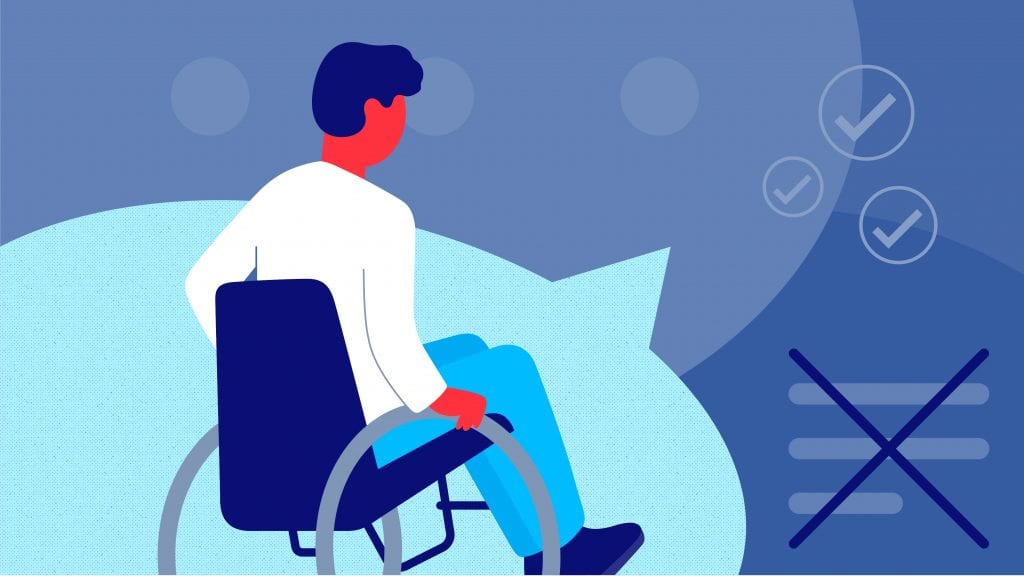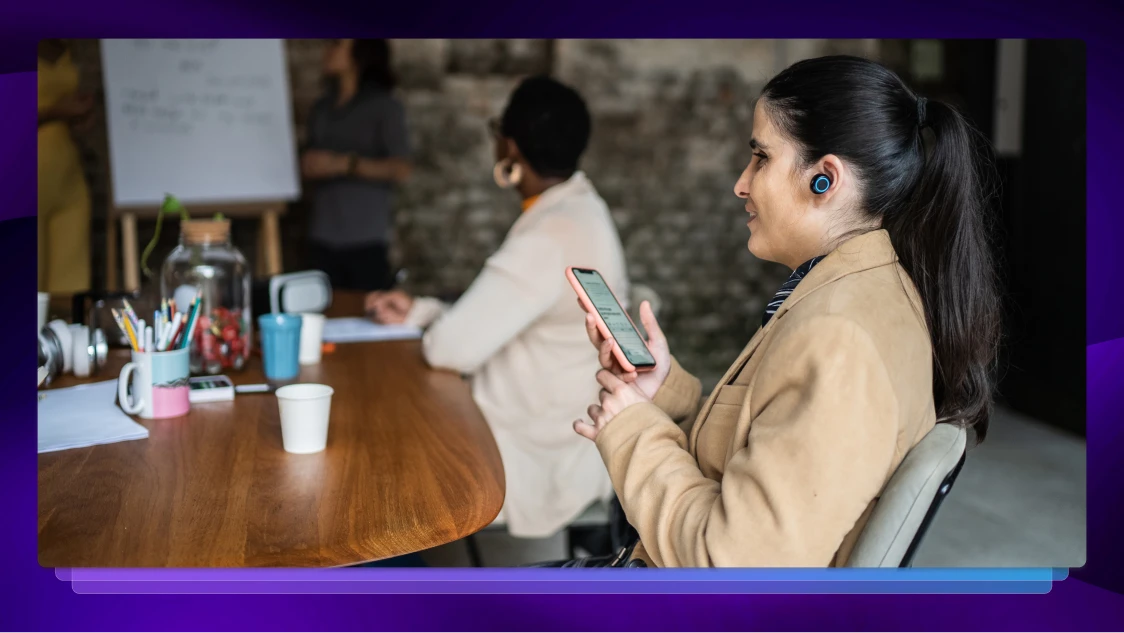How to Spot & Avoid Casual Ableism When Speaking About Disabilities
Ableism creates barriers, preventing people from participating in society. Use these language tips to promote inclusivity.

On Thursday, May 20, 2021, we’re celebrating Global Accessibility Awareness Day. Did you know that worldwide, there are over one billion people with disabilities? We hope that together, the web will become a more inclusive space for everyone. Before we get into ableism, it’s important to first understand disability.
What is a Disability?
The Americans with Disabilities Act of 1990 defines disability as “a physical or mental impairment that substantially limits one or more major life activities.”
In its definition of a disability, the act includes having a record of such an impairment. It also includes being regarded as having such an impairment.
What Areas do Disabilities Affect?
People with disabilities are diverse and have very different needs. A disability can include the loss of a limb. It could also include difficulty solving problems, or anything that restricts someone from normal daily activities, like getting health care.
Disabilities can affect the following areas:
- Vision
- Movement
- Thinking
- Remembering
- Learning
- Communicating
- Hearing
- Mental health
- Social relationships
What is “Ableism”?
When people discriminate against others with disabilities—whether they mean to or not—that’s called ableism.
Why does Ableism Matter?
Ableism matters because it creates barriers for many people and prevents them from participating in society.
A barrier could be:
- A building, service, or language that isn’t accessible
- Prejudiced attitudes
- An inflexible organization
How to Avoid Casual Ableism When Communicating About Disability
Imagine you suddenly became disabled. How would you want people to communicate with you? Chances are, you would want respect. Unfortunately, negative stereotypes about disability and prejudiced attitudes have existed for many years. This long history has resulted in outdated, disrespectful language.
Here are a few tips to communicate respectfully and avoid casual ableism:
- Focus on abilities, not limitations
- Remember that people come first
- Ask about an individual’s language preferences
- Use neutral language
- Emphasize the need for accessibility, not the presence of a disability
- Avoid condescending euphemisms
- Do not use offensive language
- Don’t mention a disability unless it’s essential to the story
Focus on Abilities, Not Limitations
It’s more empowering for people with disabilities to focus on what they can do instead of what they can’t. For example, you should say “He uses a wheelchair” instead of “He’s confined to a wheelchair.” You can also use words like “experiences” or “lives with” or “has.”
Remember that People Come First
People are always more important than their disability, and that’s the way we should talk, too. People first, then their disability. This is called People-First Language. For example, you should say “the child with epilepsy” instead of “the epileptic child.”
Ask About an Individual’s Language Preferences
Some people view their disability as an essential part of themselves, and they might prefer to be identified with their disability first. That’s called Identity-First Language. Because of this, you should always ask what an individual’s language preferences are before making any assumptions.
Use Neutral Language
Some common words like “victim,” “invalid,” or “defective” can make people with disabilities seem passive or lacking in some way. That’s why you should use neutral language. For example, say “burn survivor” instead of “burn victim,” or say “congenital disability” instead of “birth defect.”
Emphasize the Need for Accessibility, Not the Presence of a Disability
Use words like the accessible stall instead of the handicapped stall. That will emphasize the need for accessibility rather than the presence of a disability.
Avoid Condescending Euphemisms
Don’t make people feel ashamed of their disability by using condescending euphemisms. These might include differently-abled, challenged, handi-capable, or special.
Do Not Use Offensive Language
Some words and phrases should never be used, even in a joking way. Don’t use words like crazy, retard, lame, mad, freak, or psycho. These words belittle people with disabilities and normalize hate speech.
Describe People Without Disabilities
When we talk about people without disabilities, we should avoid continuing negative stereotypes about disability. That means we shouldn’t use words like “normal,” “healthy,” “able-bodies,” or “whole.” Think about it: the opposite of normal is abnormal, which is often viewed as derogatory. Instead, we should simply say “people without disabilities” or “a child without disabilities.”
Don’t Mention a Disability Unless it’s Essential to the Story
You shouldn’t draw attention to a person’s disability unless it’s important to whatever story you’re trying to tell. A person’s disability shouldn’t be the only thing that defines them to others. For example, just say “he dated a woman” instead of “he dated a woman who uses a wheelchair.”
How to Write for Web Accessibility
Why Write for Web Accessibility?
When we make digital content accessible to users with disabilities, we send the message that we know they exist and want them to join, too. Not only that, but making websites accessible is becoming more essential as business and everyday activities move online. And just as websites are becoming more important, digital accessibility lawsuits are increasing.
You should include the following when writing for web accessibility:
- Closed captions for videos
- Foreign language subtitles
- Transcripts for audio content
- Meaningful alt text for images and GIFs
- PascalCase for hashtags
- Informative page titles
- Short headings that outline the content
- Descriptive link text
- Simple language
- Easy-to-navigate formatting
Closed Captions for Videos
When creating content with both audio and visual elements, you should provide captions. Closed captions help people with hearing impairments enjoy the video sound. The captions should include spoken as well as descriptive sounds, like [clock ticks].
Foreign Language Subtitles
You should also make your content available for people who speak different languages. To reach a global audience, you can translate your captions into multiple languages.
Transcripts for Audio Content
For audio content (like podcasts), you should include a transcript. This includes videos, even though you’ll also provide closed captions. Besides spoken and descriptive sound, transcripts should also describe visual content that would help someone understand the video, like “Hamilton falls down.” Providing transcripts gives access to users who can neither hear the audio nor see the video by allowing content to be read by both screen readers and refreshable Braille devices.
Meaningful Alt Text for Images and GIFs
Non-text content like images and GIFs can be difficult for people with visual impairments. You can help with clear alternative text that describes the image. For example, say “ice cubes melting in a glass” instead of just “glass.” This makes non-text content readable to assistive technology like screen readers.
PascalCase for Hashtags
Did you know that writing hashtags with all lowercase letters is not accessible? Instead, use PascalCase. This means capitalizing the first letter of each word in your hashtag. For example, use #SavingGoals instead of #savinggoals. PascalCase is much friendlier for screen readers as well as people with dyslexia or cognitive disabilities.
Informative Page Titles
To make it easier for individuals using a screen reader to know what web page they are using, you should write descriptive page titles. Each page title should identify the main subject of the page first and then the overall site name. For example, imagine the main site belongs to an organization called Home Bank and the page is about understanding banking. The page title should be something like this: “Tips and Tricks to Understand Banking – Home Bank.”
Short Headings that Outline the Content
Each heading on a page should be short and uncomplicated. Clear headings help all readers—including screen readers—understand the page content by providing an outline. You should use the most unique, descriptive words first in the heading.
Descriptive Link Text
One of the simplest ways to make a web page accessible is to write descriptive link text. You should place the link on a phrase that describes the link target, like “to understand banking” instead of something generic like “click here.”
Simple Language
In general, it’s good practice to use clear, concise language. If you do need to use a complicated word or phrase, you should provide a definition. You should also break up large chunks of content with lists, images, illustrations, videos, etc.















